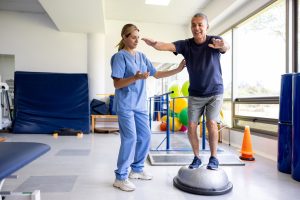What Does an Occupational Therapist Assistant Do?
Published - February 21, 2024

What Does an Occupational Therapist Assistant Do?
Occupational therapist assistants help patients develop, recover, improve, and maintain skills for daily living. They will perform the following tasks daily:
Patient Evaluation
At the beginning of treatment, the occupational therapist assistant may evaluate the patient physically and cognitively. During this phase of treatment, OTAs will review the patient’s medical history, the reasons for the visit, a diagnosis, and symptoms to understand the underlying causes of physical disabilities. OTAs use medical history to create a plan of treatment to support the patient’s pain and emotional wellness. They will review the following during an initial evaluation:
Pain Level – pain scales are used by occupational therapist assistants to understand the level of pain that a patient is experiencing. Understanding the pain level can help diagnose the cause, track how the pain level changes over time, and determine if the treatment is helping reduce the pain level.
Vital Signs – gives the OTA an understanding of what is happening inside the body. An occupational therapist assistant will check temperature, blood pressure, oxygen saturation, heart rate, and weight as a proxy for treatment success. Vital signs can help the OTA understand the activity level the patient can withstand to avoid potential concerns and injuries.
- Temperature – can help identify infection or injuries before or during therapeutic exercise.
- Blood Pressure – the force of the blood against the artery walls as it is pumped throughout the body.
- Heart Rate – the number of heartbeats per minute. Patients can have increased heart rate due to age, exercise, anxiety, or medication side effects.
- Respiration Rate – the number of breaths taken per minute.
- Oxygen Saturation – the amount of hemoglobin in the arteries, bonded to oxygen.
- Weight – a patient’s weight can determine their ability to perform vigorous exercise and indicate whether they need additional medical support.
Range of Motion – the occupational therapist assistant can measure a patient’s range of motion using a goniometer, an instrument that measures the angle at a joint. The goniometer measures the range of motion from zero to 180 degrees. A patient may experience a decreased range of motion from inflammation, pain, or other medical issues.
Muscle Strength – the occupational therapist assistant can measure a patient’s muscle strength by isolating the muscle and calculating the score on a scale from 0 to 5. An initial score will offer a starting point, and measurements can be taken from session to session.
Coordination – an OTA will test hand-eye and foot-eye coordination by throwing and catching a ball or hitting an object.
Sensory Processing – an OTA will observe the patient’s behaviors and movements as their senses are stimulated. This includes assessing an increasing amount of sensory input that a patient may experience daily.
Developing Treatment Plans
OTAs collaborate and work under the instruction of occupational therapists and carry out the treatment that the occupational therapist has planned. OTAs don’t create the treatment plan but will follow the direction of the occupational therapist and offer exercises to overcome challenges.
Implementing Therapeutic Interventions
Occupational therapist assistants help patients do therapeutic activities to increase their range of motion, balance, and walking. This includes occupational exercises to promote muscle strength and joint mobility. They may help children with disabilities perform play activities to help with coordination and socialization. OTAs also teach patients how to use therapeutic equipment.
Tracking Patient Progress
Occupational therapist assistants record patients’ progress by establishing clear and realistic goals. They must monitor changes over time and adapt the treatment to improve mental and cognitive abilities. It is essential to understand when the patient is not progressing and when a change in treatment is needed.
Administrative Duties
Part of the job of an occupational therapist assistant is to document and report patient data to the occupational therapist to review and refine the treatment plan. OTAs may work with software to keep track of patient treatment results, medical histories, vital signs, and other important medical information to help diagnose and treat patients with physical and mental disabilities.

OTAs encourage patients to complete therapeutic activities. They can help support patients by offering genuine encouragement, reassurance, and compassion. OTAs can help support patients by asking questions and offering physical gestures of affection. Part of emotional support is the ability to actively listen to and understand what a patient is going through.
Patient Education
A patient will need to understand how to use therapeutic equipment, and OTAs can offer the best form to provide their bodies with the best support. Patients will also need to know how to improve self-care between sessions and after therapy.
What are Some Specialties of Occupational Therapy?
As an occupational therapist assistant, you will have options in the type of patients you work with. Each person has their preferences, but after completing the Occupational Therapist Assistant program, you will be ready to help a wide variety of patients of different ages and socio-economic backgrounds. Some of the specialties include:
Children
OTAs work with children to improve cognitive and motor skills for sensory processing. This can help children perform motor skills such as climbing stairs, hopping, and writing.
Adults
OTAs work with disabled adults to help them learn self-care skills to gain independence and overcome physical challenges. They will also work with people who have experienced work-related injuries to help them regain the strength and abilities to return to work.
Geriatrics
OTAs help geriatric patients with stretching and exercise for rehabilitation and manage daily tasks. They help geriatric patients improve their motor skills, strength, agility, stamina, and range of motion. OTAs also communicate with family members to keep them apprised of the situation and educate them on helping their parents stay strong.
How Do You Become an Occupational Therapist Assistant?
A great way to prepare for a career as an occupational therapist assistant is by attending the OTA program at CBD College. Our classes start monthly and can be completed in as little as nine months. We help you gain credentials, knowledge, and skills so that you are ready to become a successful occupational therapist assistant.
Occupational Therapist Assistant
Let CBD College prepare you for an entry-level allied health role. As an Occupational Therapy Assistant, you can expect to work with patients by providing therapy in exciting environments such as hospitals, nursing facilities, occupational therapists’ offices, and home health services.
Contact us now to learn more.



